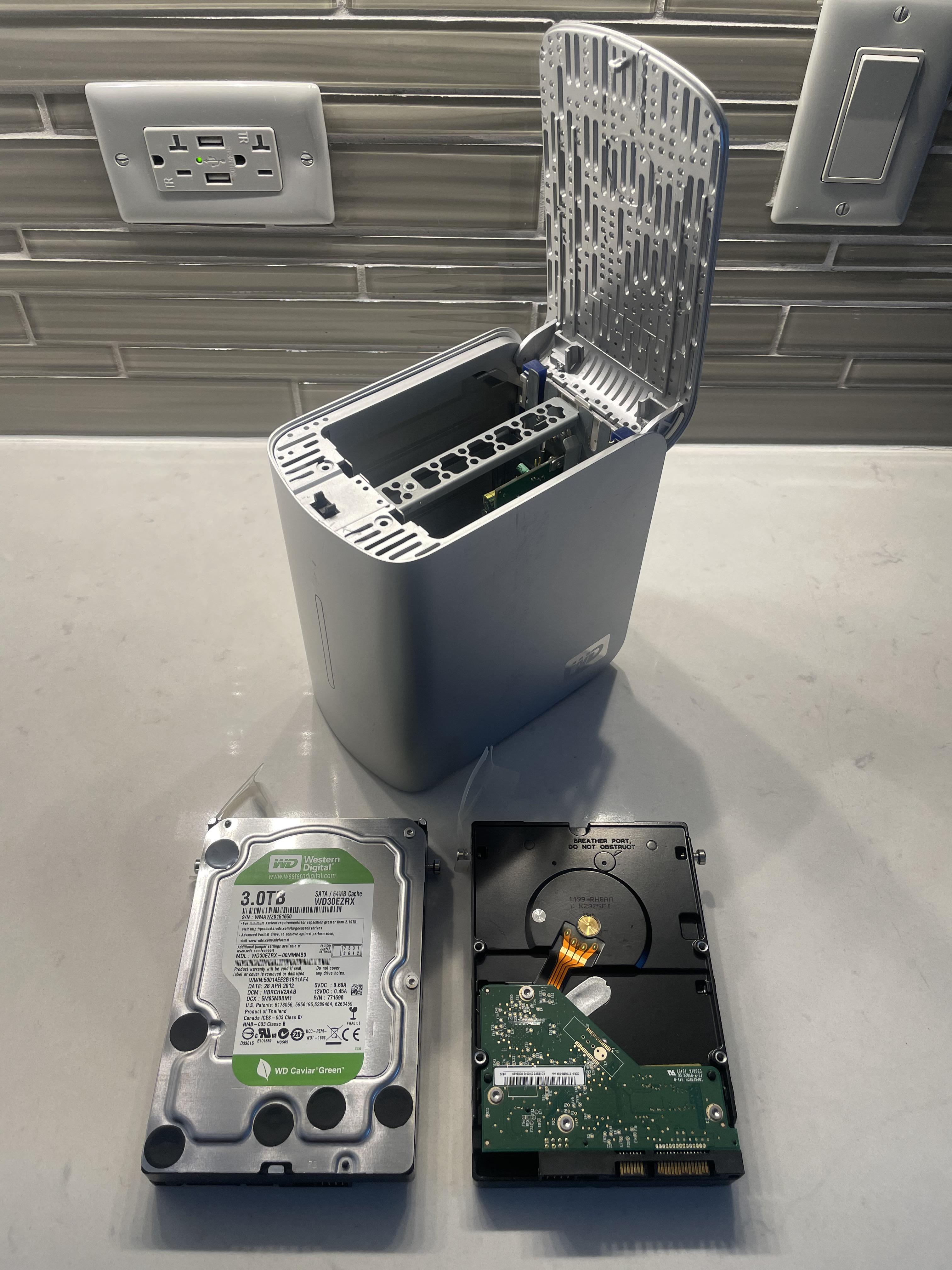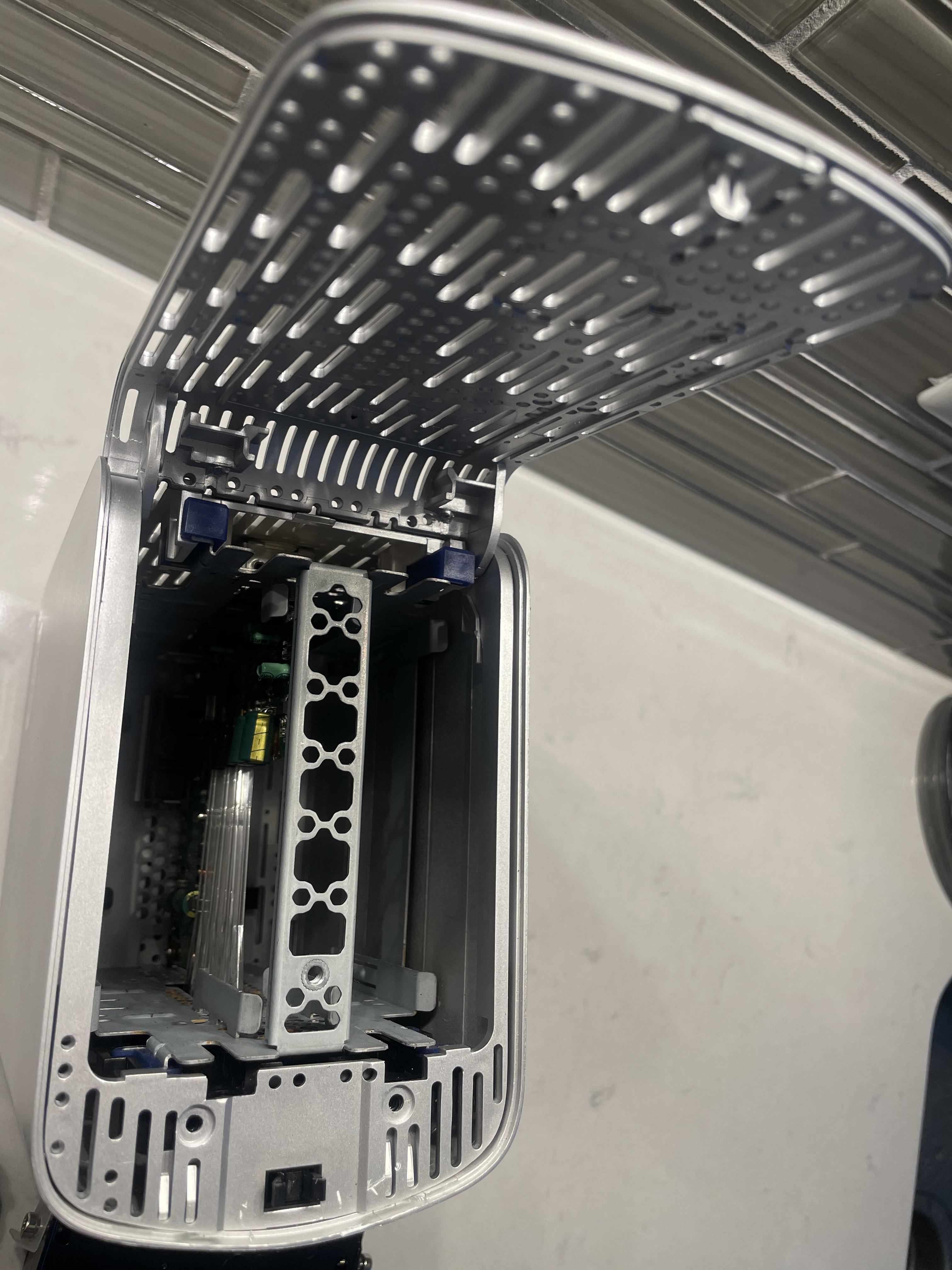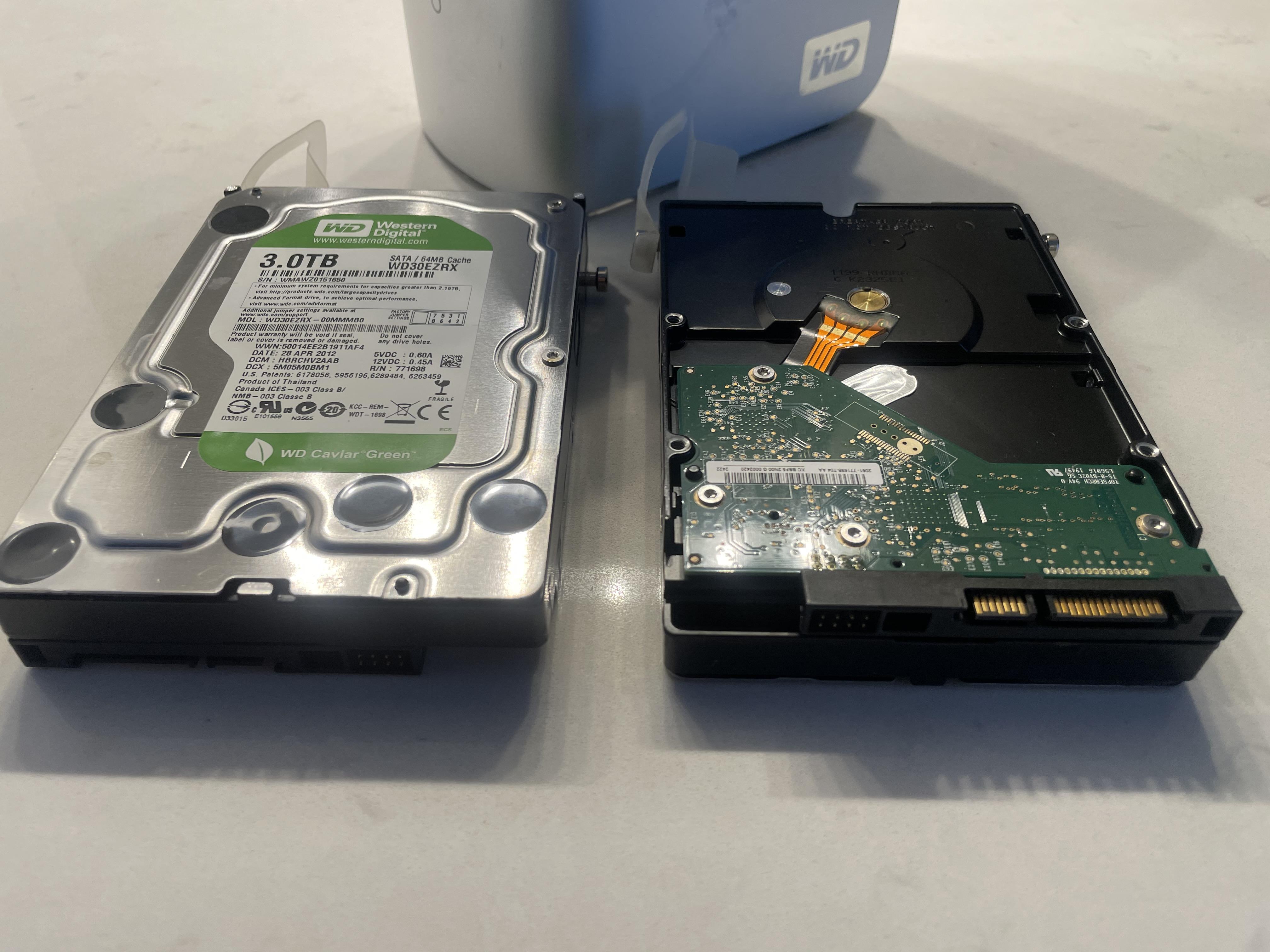Water-Damaged WD MyBook Studio Edition II Quad Interface 6TB
Hello, this is my 1st post and the reason why I joined. I have a water-damaged hard drive 6TB that had water on-or-in it for 1 day and then I dried it out. I see no water corrosion damage anywhere on the drive itself or the internal control board in the chassis or housing.
This hard drive would not power up when plugged into a 15" MacBook Pro but it did when plug into a 27" iMac using the same stock AC adapter. The power status with the 27" iMac has the front light blinking but no spinning of the platters.
I read that it could be a problem with the control board in the housing unit and to use a SATA-USB connector straight into the computer which I've done to no avail. I've tried this 3.3V pin tape-hack explained in Step 14 here -
https://www.ifixit.com/Guide/How+to+Shuck+a+WD+Elements+External+Hard+Drive/137646
...and still nothing on both drives. I don't know what else I can do which is why I'm asking you. Some extra links to the exact model I have with the online manual and attached photos. Any advice is greatly appreciated, thank you.
Online Manual - https://www.manua.ls/western-digital/my-book-studio-ii/manual
https://www.cnet.com/reviews/western-digital-my-book-studio-edition-2-review/
https://www.anandtech.com/show/4759/western-digital-my-book-studio-edition-ii-6tb-review



This hard drive would not power up when plugged into a 15" MacBook Pro but it did when plug into a 27" iMac using the same stock AC adapter. The power status with the 27" iMac has the front light blinking but no spinning of the platters.
I read that it could be a problem with the control board in the housing unit and to use a SATA-USB connector straight into the computer which I've done to no avail. I've tried this 3.3V pin tape-hack explained in Step 14 here -
https://www.ifixit.com/Guide/How+to+Shuck+a+WD+Elements+External+Hard+Drive/137646
...and still nothing on both drives. I don't know what else I can do which is why I'm asking you. Some extra links to the exact model I have with the online manual and attached photos. Any advice is greatly appreciated, thank you.
Online Manual - https://www.manua.ls/western-digital/my-book-studio-ii/manual
https://www.cnet.com/reviews/western-digital-my-book-studio-edition-2-review/
https://www.anandtech.com/show/4759/western-digital-my-book-studio-edition-ii-6tb-review
https://www.storagereview.com/review/6tb-western-digital-my-book-studio-edition-ii-review-wdh2q60000




Comments
https://www.pitsdatarecovery.net/water-damaged-hard-drive-recovered/
That WD model should be pretty common. Some services can move the platters from one drive to another for recovery. It can get expensive depending on what they have to do but I doubt they'd charge over $1000.
Upon closer inspection I see that one of these PCB's has a darker discoloration on some of the metal mounting points on the PCB. I took side-by-side pics of them here.
So I'm guessing that one of these boards had the water affect it more than the other and maybe has shorted out causing this darker burn-looking discoloration, I don't know, just speculating.
But since this is RAID 0 then I would have to replace this 1 board and reinstall it back into the original chassis and hope it starts up because I won't be able to get the to spin individually because of the RAID 0 configuration.
But I may need to replace the BIOS chip if the firmware is different. I don't know if it is just a clamp or if that chip is soldered because then I would have to bring the old and new PCB to a shop just to do that. Am I correct in any of this perhaps?
Every part of the repair is delicate and a number of things can be wrong with the drive. At least the storage is cheap enough to buy equivalent models:
https://www.amazon.com/Western-Digital-Caviar-Green-Desktop/dp/B004RORMF6/
In theory you could buy the equivalent drives and replace the parts or swap the platters over as long as the repair is done very carefully.
So I have taken the PCB off the drive casing and the other side looks good besides in 1 spot which I have circled. Not sure what those metal contacts are for?, but they are the only area that looks darkened or burnt or corroded besides the screw mounts.
The other dark areas you may see in the pic aren't actually there its only the shadow from a desk lamp to my top right. When I hit it with my flashlight they aren't there. Nothing is wet, but I'm thinking of soft cleaning the darkened metal areas with a new toothbrush and 90% isopropyl alcohol if that may do something. Or maybe the whole board as a 2nd attempt if it doesn't work.
Also if I bought a new-used My Book Studio Edition II only to use the housing and pull out the new drives and replace them with my old drives...
I was told that I don’t want to install them into another My Book Studio Edition II chassis only for the new housing PCB to detect that there was a change of drives and that new housing PCB will “helpfully” wipe the partition information so I can use them as empties, loosing all of my data.
Would either or both of these 2 statements be true? Anyone have any experience with these particular RAID 0 setup WD Green Caviar drives?
https://support-en.wd.com/app/answers/detailweb/a_id/4172/~/my-book%3A-drive-removed-from-hardware-raid-enclosure-cannot-be-read-by-a-computer
It would be best to use empty drives on a replacement enclosure in order to ensure the new enclosure is setup in the correct RAID mode. There's still a possibility that it can fail to detect the drives properly and reset them but matching the enclosure model and RAID mode is all you can do in this situation.
I think the easiest repair you could do is buy equivalent drive models, buy an equivalent enclosure, setup empty drives as RAID 0 and try the old drives in the new enclosure. If the old drives still don't power up, try switching the damaged boards on the old drives with the ones on the replacement drives. If no success after that, it would be best to look at professional drive recovery or if it's too expensive, a risky platter swap.
https://www.ebay.com/itm/195823958912
https://support-en.wd.com/app/answers/detailweb/a_id/13412
http://kamlau.com/technology/upgrading-wd-my-book-studio-ii/
"the WD Drive Manager automatically recognizes the new drive configuration and sets it up automatically with maximum capacity mode (RAID 0). Just be forewarned that all the data in the drives would be wiped clean!"
Might be worth checking with WD support to see what would happen if you drop the drives into a different enclosure:
https://community.wd.com/c/wd-external-drives/external-drives-for-mac/31
https://support-en.wd.com/app/askweb
2) or still do as I explained above but use an aftermarket dual SATA RAID docking station. BUT will that work or do I have to have the WD RAID Controller from the PCB in the housing enclosure for the 2 drives (was set up as RAID 0 by default) to co-mingle with each other to access the data? If it doesn't work then I am forced to do the 1st scenario just to use the WD housing and it's PCB.
Both approaches seem quite easy to do even for a novice like myself but the DMDE GUI does make things more simplified and explanatory. It's actually quite a powerful program.
Right now I'm testing out these 2 approaches using smaller, mostly empty other SSD's before I start my real recovery. I'm using 2 SSD 480 GB for this bench test.
I also have re-purchased the exact same model WD MyBook Studio II but with 4 TB in size (mine is 6 TB) and that is still in RAID 0 by default. (Could be used for PCB swap and BIOS ROM soldering swap if I need to)
Testing SSD source drive holds only an OSX op system at 18 GB and no other personal files. SSD destination drive is empty, and the write speed is 1% per minute so it's going to take 1 hr and 30 min to complete.
When creating a disk image or cloning it, both DD Command and DMDE wants to use the whole destination disk space. (Side Note: my recovery 6 TB RAID 0 drives have 3 to 4 TB of used data on them)
My question is: the full 3 TB Disk 1 recovery drive will be cloned to the new 4 TB Raid 0 enclosure. Then how will I be able to clone the 2nd 3 TB Disk 2 recovery drive without overwriting the first 3 TB Disk 1 recovery drive as the disk image/clone method wants to use the whole destination disk?
And if I split the new WD MyBook into 2 partitions (to not overwrite the 2nd disk image over the 1st one) then how would I be able to link up those 2 partitions in RAID 0 if it's no longer 1 drive and now 2 separate drives?
Update: I just completed a test run on the 2 SSD 500 GB's and it took 2 full hours to copy sectors to the destination drive which shows nothing copied, no change in disk info or in disk utility, how can that be?
You'd have to clone each separately - 3TB Disk 1 onto 2TB replacement 1, 3TB Disk 2 onto 2TB replacement 2, then put them back into the enclosure. I doubt this will work with resizing as the resize might not put the blocks in the same order on each drive and the hardware RAID probably has a map somewhere that notes where everything is supposed to be.
Maybe used the wrong drive destination or AFPS needs a particular drive setup:
https://apple.stackexchange.com/questions/401764/why-cant-i-just-dd-an-entire-apfs-disk
Last question on this fact-finding journey - I have this 6TB enclosure and I want to split the 2 x 3TB drives into separate drives working independently of one another, zero link, sync, stitch, communication with each other.
So not a RAID setup of any type, just regular 2 drives on their own that's it. Can I do this inside the enclosure or will the RAID controller on the PCB board in the housing prevent me from doing that and forcing a RAID set up?
For 2 regular drives in the enclosure, this would normally be a JBOD (just a bunch of disks) setup. But MyBook Studio doesn't support this mode:
https://support-en.wd.com/app/answers/detailweb/a_id/23111/~/my-book-premium-ii%2C-pro-ii%2C-studio-ii%2C-mirror-edition%3A-change-raid-level
It only supports RAID-0 and RAID-1. Changing the mode would wipe the disks. You'd need to get a different RAID box to support JBOD like these:
https://www.amazon.com/TerraMaster-Thunderbolt-Professional-Grade-External-Enclosure/dp/B07PWM5TMX
https://www.amazon.com/OWC-Mercury-Elite-Storage-Enclosure/dp/B09SC124GS
https://www.amazon.com/TerraMaster-External-Enclosure-Storage-Diskless/dp/B01MRSRQLA
SSDs are much faster, more portable and more reliable though, even if they are a bit more expensive:
https://www.amazon.com/SAMSUNG-Portable-External-MU-PH8T0S-AM/dp/B0CMDGGJTZ 8TB = $569
https://www.amazon.com/SAMSUNG-Shield-4TB-Portable-SSD/dp/B0BHZQGN26 4TB = $236
https://www.amazon.com/SanDisk-4TB-Extreme-Portable-SDSSDE61-4T00-G25/dp/B08RX4QKXS 4TB = $248
I'd rather buy a 4TB SSD (or two, can't have too many backups) than an enclosure with two standard HDDs. SSD has no spin-up time, no noise, very lightweight, drop-proof, the 4TB ones above are water-resistant, 10x faster than HDD.